Finland & Japan
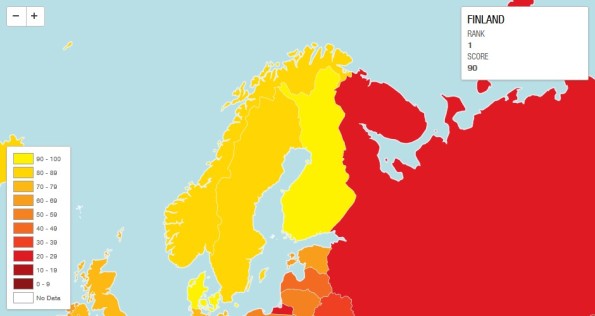
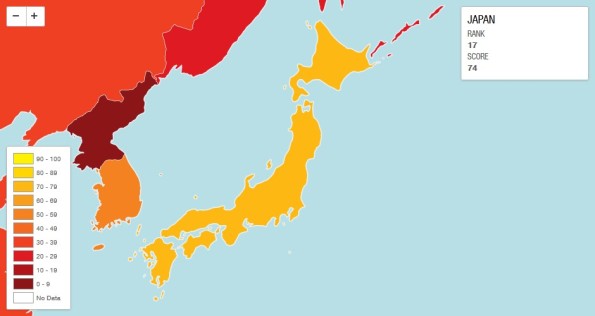
Following my previous post about national corruption, two countries brightly stand out: those are the #1 least corrupt country, Finland, and non-White Japan, a bastion of orderliness in Asia. The nations of the world generally align with HBD Chick’s hypothesis, which posits that Northwestern European countries, with their long history of outbreeding (that is, marrying outside the family), have evolved a greater sense of respect for the common good and the well-being of all countrymen (well, all people in many cases). Meanwhile, most everyone else in the world has had a long history of cousin marriage, and hence they are more concerned about the family, clan and tribe (and less concerned about everyone else). Hence, the rampant corruption in most parts of the world.
In Europe, the outbreeders were primarily found inside the Hajnal line:
This area, where marriage was traditionally late, is found to correlate with so many other things, including manorialism:
Though, in accordance with the eastern extent of manorialism, some have argued that the Hajnal line in fact extended farther east, as we see on the right map above.
IQ:
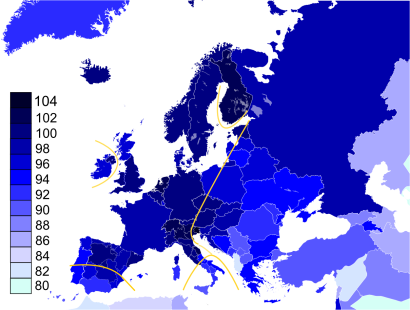
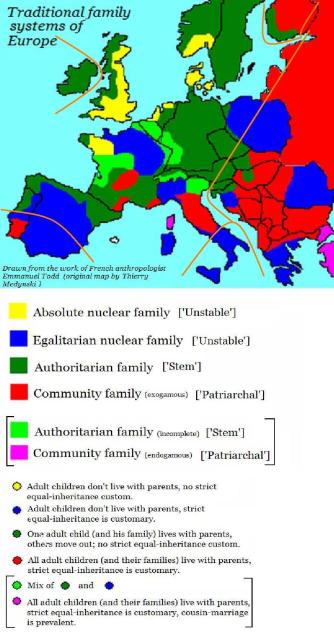
These, especially the last, will be discussed more in-depth when I talk about ideology.
However, note that Finland is situated outside the Hajnal line, and, at least by the early modern period, primarily had the Slavic-type commune-style of living and inheritance. They appear to have switched over to the stem family system coupled with Western-style late marriage by the late 18th century, however. Finnish values are closer to those of their Scandinavian neighbors than to their Slavic, ex-communist ones:
All these are despite the Finns coming into fold of the West fairly late (paradoxically, by the time Finland had passed from Swedish to Russian control). The Slavs, apparently, especially the Eastern and Southern Slavs, seem to have continued marrying their cousins for quite awhile longer—and hence remain clannish. The obvious unknown is—despite the age of marriage conforming to late Western or early Eastern patterns—did the Finns often marry their cousins? HBD Chick’s hypothesis would predict that they in fact did not—or at least, have been outbreeding for some time now.
Rapid societal change in response to a change in mating patterns appears to be quite possible, as the Scandinavians indicate. There—a few centuries after the adoption of Christianity, the society underwent a transformation from the violent, clannish world of the Vikings to the peaceable one much like we know today—in essentially an evolutionary eye blink. Perhaps a similar process occurred in Finland as well:
However, the Finns may have been outbreeding all along—or at least for a somewhat longer time than some of their neighbors to the east. Here’s some of what Wikipedia has to say about the Finnish peasantry during this time:
While the king of Sweden [sent] in his governor to rule Finland, in day to day reality the villagers ran their own affairs using traditional local assemblies (called the ting) which selected a local a “lagman”, or lawman, to enforce the norms. The Swedes used the parish system to collect taxes. The socken (local parish) was at once a community religious organization and a judicial district that administered the king’s law. The ting participated in the taxation process; taxes were collected by the bailiff, a royal appointee.[14]
In contrast to serfdom in Germany and Russia, the Finnish peasant was typically a freeholder who owned and controlled his small plot of land. There was no serfdom in which peasants were permanently attached to specific lands, and were ruled by the owners of that land. In Finland (and Sweden) the peasants formed one of the four estates and were represented in the parliament. Outside the political sphere, however, the peasants were considered at the bottom of the social order—just above vagabonds. The upper classes looked down on them as excessively prone to drunkenness and laziness, as clannish and untrustworthy, and especially as lacking honor and a sense of national spirit. This disdain dramatically changed in the 19th century when everyone idealized the peasant as the true carrier of Finnishness and the national ethos, as opposed to the Swedish-speaking elites.
The peasants were not passive; they were proud of their traditions and would band together and fight to uphold their traditional rights in the face of burdensome taxes from the king or new demands by the landowning nobility. The great “Club War” in the south in 1596-97 attacked the nobles and their new system of state feudalism; this bloody revolt was similar to other contemporary peasant wars in Europe.[15] In the north, there was less tension between nobles and peasants and more equality among peasants, due to the practice of subdividing farms among heirs, to non farm economic activities, and to the small numbers of nobility and gentry. Often the nobles and landowners were paternalistic and helpful. The Crown usually sided with the nobles, but after the “restitution” of the 1680s it ended the practice of the nobility extracting labor from the peasants and instead began a new tax system whereby royal bureaucrats collected taxes directly from the peasants, who dislike the efficient new system. After 1800 growing population pressure resulted in larger numbers of poor crofters and landless laborers and the impoverishment of small farmers
The above sounds like the details of a process of transition from a clannish, untamed society to a more democratic, civic-minded one. Some of this is no doubt due to internal population replacement ala Gregory Clark—upper class individuals were likely far more reproductively successful than the poor peons, and the latter were probably largely replaced by the former, as they seem to have been across the entire high-latitude civilized world.
As well, as per the above maps, the northern interior parts of Finland seem to have held on to their communal farming/equal inheritance systems for a lot longer than the Swedish influenced coast.
Scandinavians—including the Finns—seem to have evolved a more socialistic/collectivist—as opposed to individualistic attitude towards the common good, at least when compared to the English and Europeans farther west. This may have to do with the farming and inheritance systems they embraced and/or have something to do with their comparatively late adoption of Christianity (and hence outbreeding) and rapid pacification (perhaps a hijacking of the genes for within-clan altruism and cohesion to instead be applied towards everyone—a “quick fix” type of evolutionary change).
The communal aspect of Finnish society is quite evident is a variety of features of their society, including their dislike of competition (in stark contrast to Anglos).
The result of these processes society that frequently tops many international ratings of desirability and performance, which may ultimately be to their detriment.
Japan is a nation that is similarly contradictory, at least compared to its neighbors. The Chinese are known for their merciless exploitation of one another, which is consistent with their very long history of cousin marriage. Overall, Chinese and East Asian society in general is far more dysfunctional than in the West, with interclan conflict still an ongoing problem there.
By contrast, Japan is famed for its orderliness and within-group civility, even when tested with mighty disasters. Indeed, this national cohesiveness is so strong, it is in many ways impervious to outsiders. Japanese are averse to emigrating from Japan. More importantly, perhaps more than any other nation, Japan is poorly keen on immigration. Granted, tightly packed Japan has plenty of good basic logistical reasons to not invite foreigners, but their resistance to integrating outsiders is such that ethnic Koreans in Japan today, most of whom have been in Japan for generations and often speak only Japanese, are not regarded as Japanese citizens and treated as foreigners. Indeed, the Japanese sense of ethnic purity is such that Brazilians of Japanese descent, who were recently returning to Japan to take advantage of opportunities there, are now being paid to leave Japan and go back to where they came.
Japanese nationalism and ethnocentrism is consistent with behavior of inbred societies in the sense that the more blind form of reciprocal altruism that is common in the West, which is open to not just to non-related countrymen but all people of the world is not prevalent there. However, they do have a strong within-nation sense of cohesion that other East Asians seem to be more lacking in, a type of national cohesion that can, like that of the NW Europeans, be used to deadly effect.
According to HBD Chick’s investigations, cousin-marriage rates in Japan at the dawn of the 20th century were comparatively high (22%). These rates plunged during the course of the century, and are fairly low (4%) today. However, HBD Chick has also discovered that, at least in Europe, cousin marriage rates seem to have increased during the 19th century, so the higher values may not be indicative of earlier levels. Japanese history might offer some clues, however.
Japan was unified under the Tokugawa shogunate in 1600. This followed an earlier period internecine conflict within the country. It is possible that during this time and earlier, the levels of inbreeding were in fact lower than across the rest of East Asia. This possible limited outbreeding, coupled with Japan’s isolation, may have led to a form of parallel evolution to that of NW European one. Just as NW Europeans developed genes for reciprocal altruism over kin-based altruism, the Japanese may have developed similar genes for reciprocal altruism—with the twist being that they were still quite discriminative of Japanese vs non-Japanese. Convergent evolution often produces not exactly equivalent, albeit similar traits. Part of this may have something to do with the genes that went into the mix to begin with: selection can only work to alter gene frequency of existing alleles and de novo mutations that happen to appear during the time frame which it operates. Since East Asians were different from Europeans to begin with, similar selective pressures (such as those that occur with frequent outbreeding) can serve to produce different results.
Of course, the above is just a guess. It’s not clear what the historical degree of inbreeding/outbreeding was in Japan. The evidence only suggests that the rates of inbreeding must have been lower than in, say, China, and perhaps Korea.
As we see above on the World Values Survey graph, Japan, like Finland, is quite away from its East Asian neighbors in terms of societal values, with some affinity towards Europeans. This is even true of its fellow capitalistic, (now) democratic neighbors, South Korea, Taiwan, and Hong Kong (the latter two being populated by ethnic Chinese)—ruling out the notion that its communism and dictatorship vs Western influences/capitalism/democracy that makes the difference; the Japanese themselves are different.
While the general pattern general pattern of HBD Chick’s hypothesis appears to hold strongly across the world, there are interesting apparent exceptions. Often, much is learned about the world by examining the exceptions to the rule. Finland and Japan are two such apparent exceptions. Both are similar in many ways, and different in quite a few important ways. Also interestingly, Finland is a popular tourist destination for the Japanese. The draw of similarity remains a strong force for humanity.

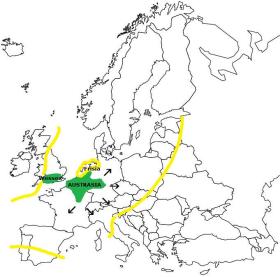



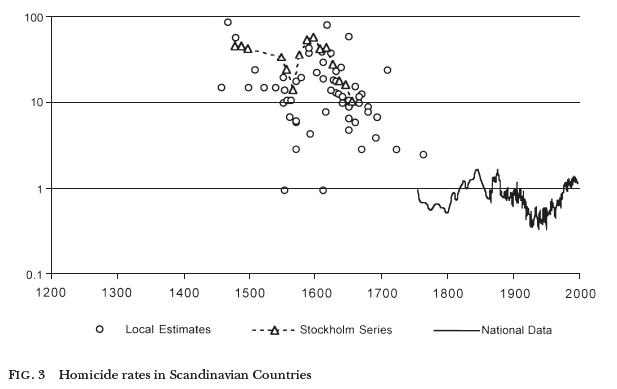






Most of the Korean presence in Japan is relatively recent. They went to Japan during the imperial period when Korea was a Japanese colony, and they never really intended to stay, but their plans were interrupted by the Korean War.
The “Brazilians of Japanese descent” are basically Latin American mestizos. They’re not really Japanese.
I believe rates of inbreeding have been lower in Korea than Japan.
Other East Asian nations such as South Korea and China are also noted for their nationalism. There’s no real indication that Japan is more nationalistic.
Japan appears to be less clannish, at least with respect to China, anyway.
Japan’s ability to remain racist and resist the Cathedral is quite remarkable. Especially when you consider that their entitlement problem is way bigger then ours. To be able to keep their eye on the 100 or 1000 year prize in the face of some hard decades is remarkable.
Another interesting thing about Japanese racism is that its a shy as everything else in Japan. A racist redneck might go around calling people slurs and causing a stir, but in Japan they just kind of politely don’t let you into the inner circle. In all honesty a racist Japanese is probably more polite then a tolerant westerner.
I think one reason that people don’t mind Japanese racism too much is that they will still A) employ you and B) their women like sleeping with foreign men.
You must not be a redneck or not know any, racist or otherwise. Rednecks tend to be polite, and racist rednecks tend to be polite to non-whites as well.
No, they won’t employ non-East Asians outside of being English teachers largely. English teachers are poorly paid, looked down upon and abused in the press, and have limited time periods they can stay in Japan. There is no upward mobility for non-East Asians in Japan or East Asia for that matter. They make sure the employment situation is so hostile that non-East Asians leave after awhile.
Most people who do JAP really like it. If you graduated with a liberal arts degree from a shitty school then JAP probably pays better then many of the jobs you’d get in the states right after college. Add in the fact that getting paid in yen is a huge windfall these days and it ain’t a bad deal at all. Everyone I know that has done JAP liked it.
If you are have a rare skill they will also make accommodations. Japan is cool with rich dudes.
What they won’t do is led mediocre middle class people work there. If you don’t have some skill the Japanese don’t have why would they keep you.
Opinions going back decades have shown that indigenous Westerners have opposed immigration from non-related peoples. Polls have consistently shown this. Behaviors such as “white flight” have consistently shown this. Common views from just a few generations ago show this:
http://racehist.blogspot.com/2010/03/more-from-henry-cabot-lodge-on-race-and.html
The simple answer is that the “commanding heights” of Japanese society, the positions of political and moral authority, social and cultural influence, remained in the hands of the Japanese. This was not in the case of the US, where these positions were wrested from the majority by a hostile minority, and the rest is history.
Also opening a country “to not just to non-related countrymen but all people of the world” is not an example of reciprocal altruism. There is no tit for tat there. It would be an example of (pseudo) kin-altruism, where non kin are treated as kin.
But why? Why are the elites interests still kind of aligned with the plebs interests. I mean presumably there are interests in Japan that would profit from cheap labor just as they do in America. How do they keep the solidarity?
This happens sometimes throughout history. In reading about early Roman history I’m amazed how seriously the elite took the same moral philosophy and ethnic interest they peddled to the plebs themselves. Sure there was a good deal of corruption, but the early Roman elite really did put Rome first many times.
Japan lost a war, had two atom bombs dropped on them, and was occupied by Cathedral states for many years. They even had their own hippie movement in the 60s too. Yet today they survive, and will go on surviving.
The fact that non-Europeans decide to have children and raise them in European societies says everything. European people are not hostile enough that non-Europeans decide not to stay to have children and raise them. European societies has fostered the breeding of non-Europeans. The reverse can not be said. European people don’t want to have children in non-European societies (unless their spouse is of a different race then there is a possibility of that happening). And they can’t do it because those non-European societies doesn’t offer everything a European society does.
Latin Americans are more outbred than usual, considering that history of interracial sex and marriage there, and yet Latin American countries exhibit high levels of corruption. I’d be interesting to know what the story is there. Did the predominantly European upper-class of Latin America continue its practice of cousin marriage up until recently?
I would guess it has a lot to do with the fact that the upper classes feel little solidarity with the lower classes (and vice versa), since they are from different races with a long history of conflict.
Inbreeding or outbreeding, when you live in a small, isolated community, after a few decades, everyone is related. Japan is an archipelago which has historically had extremely limited contact with the outside world. So Japan is just a really BIG clan. There’s very little corruption and violence because you don’t screw over or attack your own family. And there’s little interest in foreigners (other than Americans) because they aren’t part of the family.
@jayman – “Scandinavians—including the Finns—seem to have evolved a more socialistic/collectivist—as opposed to individualistic attitude towards the common good, at least when compared to the English and Europeans farther west. This may have to do with the farming and inheritance systems they embraced and/or have something to do with their comparatively late adoption of Christianity (and hence outbreeding) and rapid pacification (perhaps a hijacking of the genes for within-clan altruism and cohesion to instead be applied towards everyone—a “quick fix” type of evolutionary change).”
i’ve been thinking that, perhaps, the difference between the scandis and the english/dutch is related to timing — i.e. that since the scandis converted to christianity slightly later than the anglo-saxons/dutch, and so (presumably) started outbreeding later than the anglo-saxons/dutch, that they’re sort-of not as far along on becoming “atomized” individuals.
but it seems as though there’s something more to it than that. the scandinavians might be 300-400 years behind on the nw european outbreeding project, but england of 300-400 years ago was nothing like scandinavia today, so it’s not just a matter of timing.
on the whole, germanics (including scandinavians) seem — to me — to like, you know, ordnung! (~_^) in a way that is reminiscent of the east asian drd4/lack of adhd-related alleles. i wonder if there’s something there, too, with the germanics (anybody know?). maybe this contributes to their strong group preference attitudes.
having said all that, finnish folks are not germanics (of course!). i’ve got some stuff, which i will post, on the finns — mitterauer in Why Europe? describes them as very clannish/tribal in the medieval period, so i would guess plenty of inbreeding at that time. what happened subsequently, i don’t know. i’ll post what i’ve got. (^_^)
btw — how many swedes settled in finland? and how much influence have they had on finnish society? more things i don’t know….
and the japanese? i’m just going to reserve commenting on them — ’cause i simply don’t know the story there. commenter spike gomes suggested a while back that there might have been a general trend towards outbreeding in japan during the seventeenth to nineteenth centuries, but i haven’t had an opportunity to check on that.
Indeed. The difference with the Scandis wrt to other NW Europeans must be due to one of these two (not mutually exclusive) factors:
About that last point, the English and other Anglo-Saxons appear to be unique, even among NW Europeans. It could have something to do with their adoption of nuclear families (or, this is another result with a common cause). After all, if you’re on your own to make your own way through the world and can’t necessarily count on family, you’re going to be under a different set of selective pressures than an individual who can count on receiving his inherited parcel.
I look forward to it!
Well, apparently, the coastal parts of Finland, the parts that appear green in M.G.’s map, was apparently the center of Swedish settlement there. However, genetically speaking, the Finns are quite distinct from other Europeans, so it’s unclear how much of an impact Swedish admixture had on them.
I’ve noted something similar. The Tokugawa period seems to be the era where the modern, unified Japan got going.
The whole “Japanese exception” thing can be easily explained by the fact that the Japanese are very corrupt, but are just better at sticking their heads in the sand than other countries.
@jayman – “Japan was unified under the Tokugawa shogunate in 1600. This followed an earlier period internecine conflict within the country.”
the tokugawa shogunate was a clan run operation, so i smell close marriages (could be wrong, though! — needs to be confirmed of course).
could’ve been less/progressively less inbreeding in japan than other parts of east asia (like china) from the tokugawa period (or a bit earlier) down to today. in the late 1800s/1900s there were powerful kuge families, but it sounds like they weren’t as “clannish” as the earlier clans were. dunno.
@jayman – ” HBD Chick has also discovered that, at least in Europe, cousin marriage rates seem to have increased during the 19th century, so the higher values may not be indicative of earlier levels.”
yes. always important to remember!
other examples of areas where inbreeding could’ve been (probably was, i’d guess) lower in the past than the present are those areas that were “arabized” in the medieval period — especially the maghreb (especially very far to the west) and parts of south asia like pakistan and afghanistan. they might’ve been marrying cousins before they adopted islam, but they then likely switched to fbd marriage, which leads to greater inbreeding, yada, yada, yada….
ok. now i’m rambling. it’s late. (^_^)
I think part of it may be due to population size i.e. the same level of outbreeding can end in a different level of average cousinage depending on the size of the population. Counter-intuitively the effect is to increase nepotism but on a different scale i.e. it increases national nepotism because the people of a (small) and/or relatively isolated nation that goes through the process still up quite closely related.
I think ordnung expalins part of it also – like the length of Russian guts the further north you go the harsher the environment and the more people have to adapt to it.
Makes sense. But while this works for the Nordic countries, it doesn’t seem to work for Japan, because I’m assuming that their population was considerably larger than any of the Nordic countries’.
nb not all of it though.
Youre full of shit jayman, you make constantly excuses you say inbreeding has an effect on IQ while japan which inbreed very much has one of the highest the same for all the other east asians.
All else being equal, inbreeding depresses IQ, but it’s mostly for first cousin marriage. But the negative impact of inbreeding can be counteracted if there is strong enough selection for intelligence, which there appears to have been in Japan. As well, there is evidence that suggests that average IQs rose in Japan after they stopped inbreeding.
A full 70% of the Finns are of Scandinavian descent, the rest are Ugrians.
The Finns never connected with the Slavs.
Finland and Estonia were populated from Denmark, Sweden and Norway already in the 8th century.
Placenames in these countries tell us that.
However, we do not know when the Ugrian people influx to these countries happened, if it was before , or simultaneously with the Scandinavian settlement.
As a Norwegian myself, I think there is little evidence that the society changed much post-viking age.
The Viking-age seems violent if we read the sagas, but the sagas are hero-stories, as well as stories the writer made up to make certain kings and chieftains look bad. These latter were often paid for by the reigning king…….
Murder rates were probably low all along. We have had criminal and civil courts from the 8th century, that is 1200 years with a working judicial system. The jury system of 12 jurors came from us to Normandy and England. (The Romans had their system 1000 years before that, with the 150 to 350 man “juries”. Though those juries only judged eloquence, as the ones who knew the law were minor players in that system.)
Today there are around 30 murders a year in a population of 5 million people in Norway (2011 excepted-with Breivik killing off 77…).
Of those 30 murders, 20 are committed by immigrants to Norway…..however only 5 of the victims are immigrants……
20% of Norway´s population are immigrants, all arrived after 1970 (counting in their offspring in this number).
A full 60% of the prison population in Norway are immigrants…..
Don’t be so sure. Finns are genetically distinct from Swedes and Slavs, indeed, from all other Europeans.
Not clear, as you can see from the above link.
Nope. Check out the data.
Indeed, sadly… 😦
Again, we are not talking about the Saami, even if the Saami language are related to the Finnish language, the Saami people are not Finns. There are 25 000 Saami in Norway, around 3000 in Sweden ,around 3000 i Finland, and 10 000 in Russia.
A gene mapping 5 years ago discovered that 70% of the Finns had Scandinavian heritage, and even if only 6% of Finns have Swedish as their mother tongue today, the genes are not liars….
As for crime rates, before the year 1600 very little remains of court records (most local courts in Norway were built of wood, and when they caught fire in thunderstorms, all records went), so murder rates before 1600 is pure conjecture, and between 1600 and 1800 unreliable since the material is extrapolated.
I spent two years in Finland, and know that all along the coastal regions the girls look Scandinavian, whereas the inland girls are of the less attractive Finnish type…… (Beware!this is a generalisation!)
Look at the chart again. We are not talking the Saami, we are talking about Finnish Finns. They are genetically distinct from Scandinavians and Slavs alike.
Do you have a link? Hopefully we’re not talking about Y-chromosome/mtDNA analysis. Having some Scandinavia heritage is a different matter from being primarily descended from a certain group.
There is some data going back to the 1400s. All across Europe, homicide rates were high during this time.
There is indeed a gap for Scandinavia. But a steep drop off was observed elsewhere and there is a distinct discontinuity before and after in Scandinavia consistent with a steep decline.
Interesting. Swedish settlement did seem to happen along the coast in Finland.
So the racial joke about how Japanese are the Aryans of the East, and the Chinese are the Hebrews of the East is kinda true after a fashion
The hypothesis is circular and the effects of the history not empirically tested and thus just-so. Ergo, the hypothesis is useless since even ignoring the badly defined outbreeding, you asserted history that leads to clannishness that leads to corruption of these countries to prove the validity of your hypothesis of clannishness. It’s an unnecessary plug-in. If you claim that a particular modern behavior is caused by a particular psychological structure that arose due to particular selection pressures, then you need to show that a particular structure causes that behavior and that it was in fact selected to produce that behavior. Of course you never establish direction of causation. Evolutionary psychologists are a joke.
Twin studies exist, you know. The human mind is the product of evolution. While there details of how aspects of the brain evolved and for what, there is no question evolution is involved.